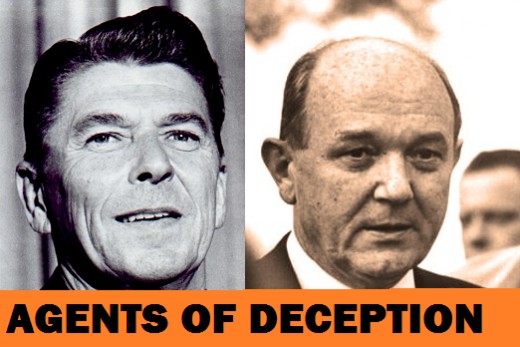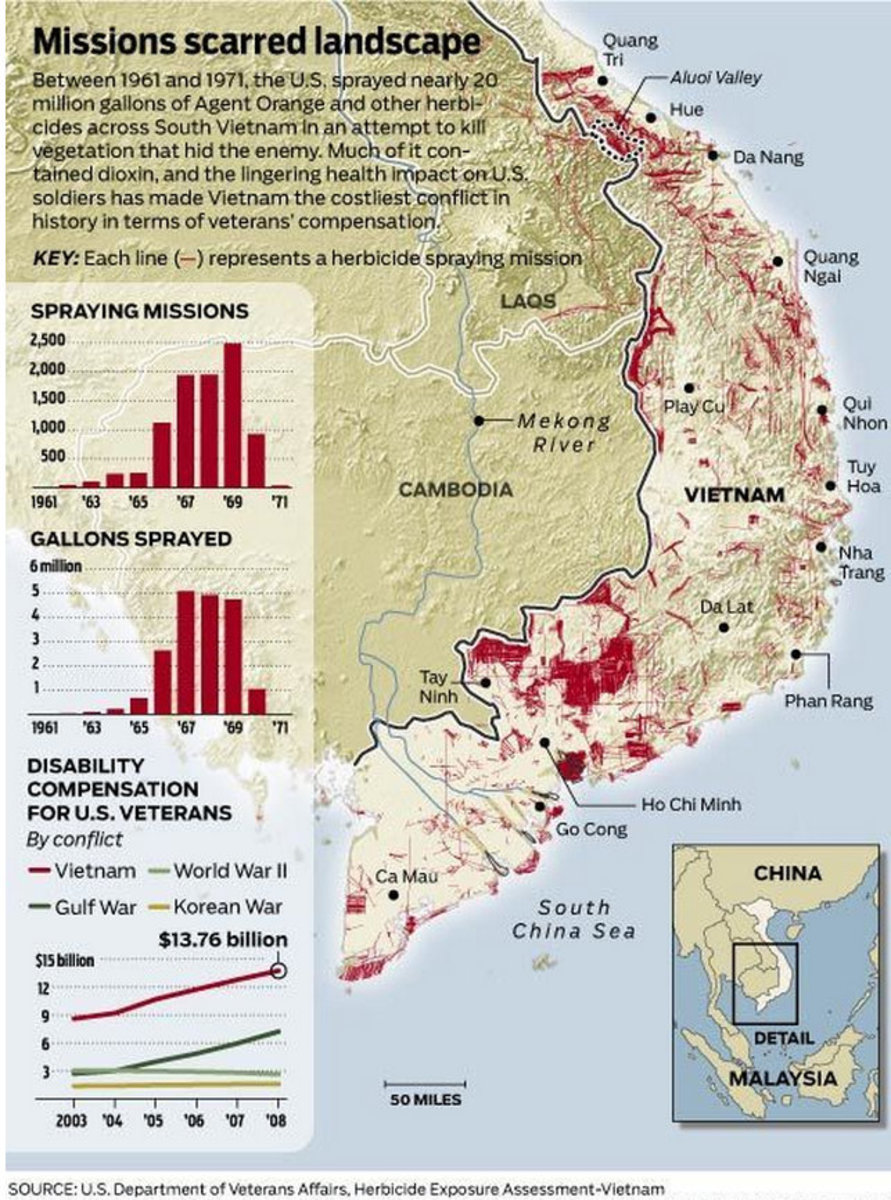Agent Orange and the Agents of Deception
This is the fourth in a series detailing the discovery, the military use, the legal battles over the damaging effects, and the massive ongoing cover-up of Monsanto's Agent Orange.

During WWII, Professor E. J. Kraus, chairman of the school's botany department, discovered he could regulate the growth of plants by use of various plant hormones. Like Dr. Arthur Galston who discovered the effects and properties of TIBA (triiodobenzoic acid), also known as 2,4, 5-T, Dr. Kraus learned that heavy applications of 2,4,-D (dichlorophenoxyacetic acid) would increase growth spurts, which would quickly kill them as quickly as 24-48 hours following application. Thinking his discovery might be of use to the military, he contacted the War Department. However, it was too late in the war for a use to be found, though civilian scientists quickly created chemical sprays for use in controlling weeds in family yards and along roads and railroads.
Throughout the 1950's, Army scientists continued to experiment with 2,4-D. Toward the end of the decade, they found a potent combination of chemicals which quickly became a part of the military's chemical arsenal. When 2,4,-D was mixed with 2,4,5-T and sprayed on plants, it had an almost immediate defoliating effect. If we believe their claims today, they didn't realize that 2,4,5-T contained the useless by-product of production processes called dioxin. Twenty years later, concern was raised about the toxicity of dioxin. The EPA would eventually call it “one of the most potentially dangerous” chemicals known to mankind.
Since then the Encyclopedia Britannica claims,"The toxicity of dioxin renders it capable of killing some species of newborn mammals and fish at levels of five parts per trillion (or one ounce in six million tons). Less than two millionths of an ounce will kill a mouse. Its toxic properties are enhanced by the fact that it can pass into the body through all major routes of entry, including the skin (by direct contact), the lungs (by inhaling dust, fumes or vapors), or through the mouth. Entry through any of these routes contributes to the total body burden.” Dioxin is so extremely toxic because “Contained in cell membranes are protein molecules, called receptors, that normally function to move substances into the cell. Dioxin avidly binds to these receptors and, as a result, is rapidly transported into the cytoplasm and nucleus of the cell, where it causes changes in cellular procession."
With very little experimentation, in 1961, the US military/government acquiesced to the request of South Vietnamese President Ngo Dinh Diem for aid in his fight against guerrilla forces. By September of 1962 the spraying program, Operation Ranch Hand, had been stepped up. Over the next nine years a total of 20 million gallons had been sprayed at a concentration rate thirteen times that of the dose used domestically.
While government and military officials have maintained that they were unaware of the dangers of Agent Orange, industry producers were not. In February 1965, a Dow Chemical Corporation internal memo presented a summary of a meeting among thirteen executives concerned about the potential hazards of dioxin in 2,4,5-T. One month later, Dow convened a meeting with executives of Monsanto and the other five chemical companies tapped for executing government contracts to produce Agent Orange. Uncovered years later, the documents provide proof that the purpose of the meeting was “to discuss the toxicological problems caused by the presence of certain highly toxic impurities in samples of 2,3,5-T. The main impurity to be discussed was 2,3,7,8-TCDD, the most toxic of the 75 dioxin compounds.
Early records and testimony from at least one meeting participant indicate that Dow was adamant about keeping the information secret from the military and the US government. Dow was worried that the government might find out about a study that indicated dioxin caused severe liver damage in rabbits and that there would be resulting government restrictions on the industry.
Industry executives needn't have worried. Uncovered documents in the National Archives, as well as the words of scientists involved in Operation Ranch Hand present the truth of the situation. Military officials were well aware of the potential long-term risks of frequent spraying. Dr. James Clary helped write the history of Operation Ranch Hand. He was an Air Force scientist who served in Vietnam and says that the Air Force knew Agent Orange was far more dangerous than anyone wanted to admit at the time. In his letter to Congress in 1988, Clary admits being aware of potential damage due to dioxin contamination in the herbicide, but because it was being used on the “enemy”, they weren't concerned.

As early as January 1966, military officials were aware of “mist drift”, and a memo dated the 24th addressed an incident of damaged rubber trees growing more than 500 yards away from a spray area. By November of 1967, a memo from the deputy US ambassador in Saigon addressed the mist drift yet, again. This time the range had covered more than six miles. It can't be ignored that officials had to realize that American troops within the range were being exposed through dioxin laced food and water. And yet the dumping of millions of gallons of dioxin contaminated Agent Orange continued throughout the war years.
Through the 1960's, chemical executives continued to insist on the safety of Agent Orange. When more than 50 employees at a Diamond-Shamrock plant began suffering from “painful and disfiguring” skin diseases, Dr. Roger Brodkin, head of dermatology at the University of Medicine and Dentristry of New Jersey, alerted state health officials. He claims state officials came to the site, looked around nodding, said “Ah, hah,” and then left. They never did anything about it.
Eventually, employees began showing signs of liver damage. By the time New Jersey got around to testing the soil near the plant, it was 1983. Extremely dangerous levels of dioxin were found and those living within 300 yards of the plant were urged to move by Governor Thomas Keen.
The American Association for the Advancement of Science (AAAS) was becoming concerned by the use of dioxin containing herbicides being sprayed over populated areas and the food supplies of the Vietnamese. They sent a letter to the Secretaries of State and Defense urging a study to determine the ecological effects.
In response, Secretary of State Dean Rusk suggested releasing “certain non-sensitive” segments of an ecological study done earlier the same year (1968) by Dr. Fred H. Tschirley who was employed by the US Dept. of Agriculture. He had traveled to Vietnam and in his report he foresaw no long-term ecological impact on the country as a result of herbicide spraying. When the report was released to the public, Rusk didn't bother to mention that it had been edited to reflect the results the state wished to reflect.
Veterans tell stories of being soaked when planes flew overhead releasing their poison loads. Food, clothing, drinking water...all were drenched in the downpours. Some of the troops were genius in making use of empty Agent Orange barrels. They were used as barbecue pits, as storage for watermelons and potatoes. Some soldiers even removed the lids from the drums and rigged showers for bathing. After all, they had been assured the chemicals previously contained in them were harmless.

The defoliation program in Vietnam was ended in 1971, but that was too late for the thousands of soldiers who had fought there. In the years following their tours, many of them realized they had survived the fighting, only to come home and die painful deaths fraught with cancers, liver failures, and constant pain. Children, conceived after their fathers returned home from the front, often had severe birth defects. Wives had high incidences of miscarriage and stillbirth. A great number of these veterans had high dioxin levels in their blood, but scientists and the US government continued with their claims regarding the safety of Agent Orange.
Then dioxin related events outside the Vietnam War began to get media coverage. The industrial accident in Seveso, Italy caused contamination across eleven communities and today is rated with disasters like Chernobyl and Bhopal. The small rural town of Times Beach, Missouri was discovered to have been contaminated when dioxin laced oil was spread on its dirt roads to reduce dust. Soil samples showed 33,000 times the amount of dioxin compared to EPA standards. The entire town was evacuated and purchased by the federal government with Superfunds. Word of atrocious child defects born to Vietnamese mothers was getting out, as well as the climbing rates of cancer and chloracne associated with dioxin poisoning.
The media focus served to heat up the debate over the safety of the chemicals. The EPA placed a ban on products containing dioxin being sold on the market. And still the Veterans Administration denied benefits to veterans exposed to Agent Orange because scientists and select government officials maintained that there was no link of the herbicide to the illnesses. The American Medical Association took a stance of wanting to “prevent irrational reaction and unjustified public fright”. President Ronald Reagan embraced the stance, calling it “a positive step toward a more reasonable public debate” on the issue.
When lawsuits hit the circuit courts, Judge Jack Weinstein overstepped his bounds, by creating new rules of law and demanding adherence to the settlement he crafted, denying the plaintiffs their litigation rights. Every action undertaken by this judge who received his paycheck from the Federal government, was designed to accommodate Monsanto, Dow, and the rest while denying any kind of hazardous liabilities on their parts.
Documented studies submitted by Monsanto to the EPA have proved to be fraudulent, but the government has basically stymied any effort at criminal prosecution. Superiors in the EPA harassed a whistleblower who prompted the criminal prosecution, and then closed the investigation on their own fraudulent terms. The CDC has failed to follow through with orders to conduct a study on long term effects of Agent Orange exposure, using individual soldiers who had been exposed in the war. Several times they changed their protocol, eventually claiming the impossibility of completing an accurate study by siting reasons having to do with the unavailability of individual movements throughout the soldiers' tours. It was a poor excuse as the military records are accurate and available. But it was a clever way to avoid identifying the soldiers who suffered the heaviest exposure of the agent.
The House Committee in its 1990 report found that the 1987 study abandoned by the CDC was done so because of pressures from the White House. “A possible reason that the White House chose this path is revealed in confidential documents prepared by attorneys in OMB (Office of Management and Budget). The White House was deeply concerned that the Federal Government would be placed in the position of paying compensation to veterans suffering diseases related to Agent Orange and, moreover, feared that providing help to Vietnam veterans would set the precedent of having the US compensate civilian victims of toxic contaminant exposure, too.”
- A Fraud Called Agent Orange
This is the first in a series of articles detailing the discovery, the military use, the legal battles faced by victims, and the massive ongoing cover-up of the deadly chemical manufactured by Monsanto, Agent Orange. Step into the courtroom of Judge - The Roots of Agent Orange
This is the second in a series of articles detailing the discovery, the military use, the legal battles faced by victims, and the massive ongoing cover-up of the deadly chemical manufactured by Monsanto, Agent Orange. Step into the aftermath of the V - Secret Agent Orange: A Monsanto Web of Deceit
This is the third in a series of articles detailing the discovery, the military use, the legal battles faced by victims, and the massive ongoing cover-up of the deadly chemical manufactured by Monsanto, Agent Orange. Read here the web of lies spun by - Agent Orange Blues: How Vietnam Navy Veterans Were Scuttled
This is the fifth in a series of articles detailing the discovery, the military use, the legal battles faced by victims, and the massive ongoing cover-up of the deadly chemical manufactured by Monsanto, Agent Orange. Discover the battle of US Navy Ve
It's been more than 20 years since the House Committee issued the above report. Advances have been made toward securing the veteran's benefits so many of our soldiers need and deserve. But the fight continues. The evidence of the dangers of dioxin have continued to pile up, and yet, the Veteran's Administration continues to fight the obvious. Over the years, more and more studies give proof that dioxins are responsible for still more illnesses and injuries than previously believed. The dioxin contained in Agent Orange has been awarded the dubious rank of most toxic of them all. In the face of such knowledge and certainty, how can officials give voice to any remaining doubts. How can there even be any remaining doubts?
There's no doubt that money has always been at the base of the travesty known as the Agent Orange question. But the real question is...Whose money? We know the manufacturers were protecting their company's bottom line with the blood of our servicemen. It's a given. However, were those filling out the ranks of government agencies, of military's top brass, of political electees and appointees really protecting the health of the US treasury? Or were they protecting their own fortunes? Were they heavily invested in Monsanto, Dow, Uniroyal and others? Did their investment portfolios contain holdings in other manufacturing companies where the dioxin question would most certainly shrink the net profits to be shared among stockholders?
Or was there something even more sinister? Why was our government endorsing the destruction of crops and farmland of the civilian population we professed to be liberating? Our government has a long history of deferring to Monsanto's wishes, beginning with Agent Orange and following up to the present day demands of approval for GM foods, whose affects have not had proper testing for safety. Was it money or was it power that ruled the day?
If this is an important issue to you or you find the information helpful, please pass it on by clicking the Tweet, Like, +1, or Pinterest buttons provided at the top of the page.
Also feel free to leave a comment or tell your own Agent Orange story.






